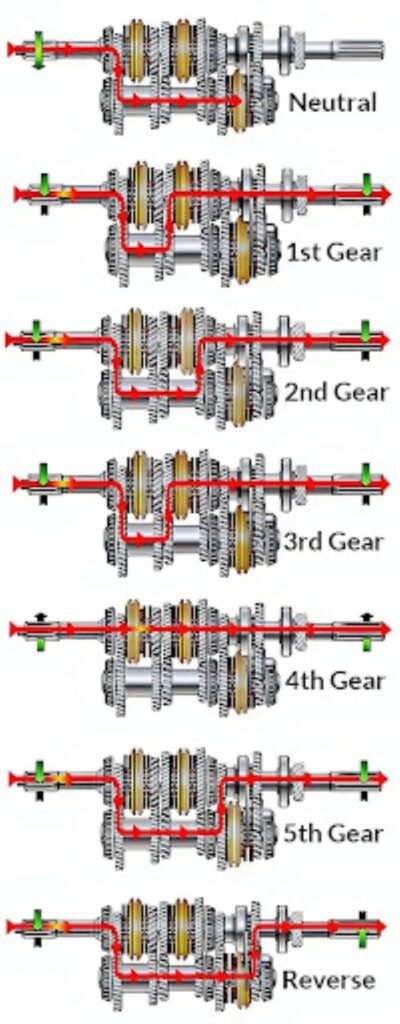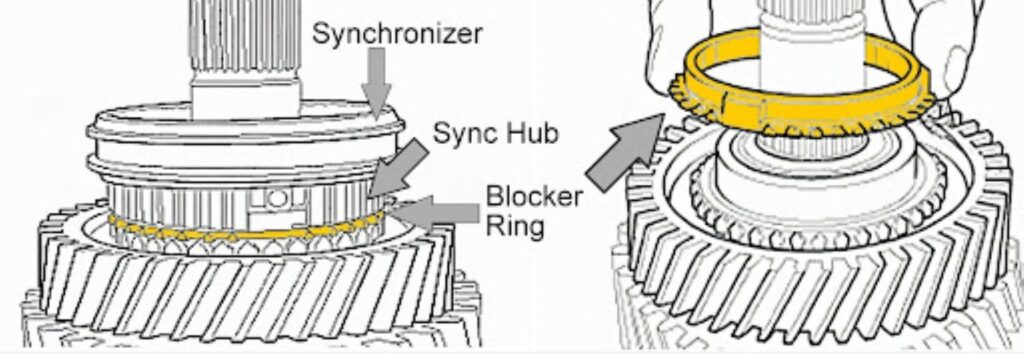Shifting gears is an essential part of driving. That’s why it’s especially troubling if your manual car is having a hard time shifting into first gear. But what are the potential reasons behind these first-gear transmission problems, and are there any solutions out there?
Understanding Gear Shifting
To understand the causes behind your manual transmission not shifting into first gear, if you’re sure the clutch is fully releasing, you need to understand gear synchronization and gear ratios.

Gear Synchronization
Gear synchronization is the process of adjusting the speed of the input and output shafts in your gearbox so they work completely in sync. Their speed is measured in rotations per minute (RPM).
When shifting between gears, the process isn’t instantaneous. Shifting between the gears can’t easily be done while power is being transmitted through the gears unless you’re very familiar with feathering the accelerator to find the sweet spot where you can catch the next gear. Heavy trucks don’t have synchronizers and truck drivers do it all the time.
Manual transmission vehicles are equipped with a synchronizer (the shift fork moves the synchronizer between two different gears, like 1st and 2nd, or 3rd and 4th) and a special “blocker ring” that floats between the fork-driven synchronizer and each of its gears is responsible for synchronizing the speed of the target to match the speed of the input shaft for clash-free shifting.

This blocker ring is usually made of brass and always has a slight cone shape on the inside with tread lines or a lining on the inside that matches the cone shaped surface of the gear on which it rides to force the target gear to speed up or slow down.
Manual transmission vehicles are equipped with a synchronizer and a special “blocker ring” that floats between the fork-driven synchronizer, and each of its gears is responsible for synchronizing the speed of the target to match the speed of the input shaft for clash-free shifting.
–Richard McCuistian, ASE Certified Master Automobile Technician
It’s the synchronizer’s job to close the gap in RPM between gears as much as possible before a shift. This shift is more drastic between the first and second gears than the other gears due to gear ratios.
Gear Ratios
Gear ratios refer to the number of times one gear in your transmission needs to turn for another gear in the system to turn once. For instance, a gear that rotates twice for every single rotation of its partner gear would have its gear ratio listed as 2:1. In terms of gear shifting, each gear has a different gear ratio. You’re likely used to shifting into first gear primarily when starting your vehicle from a stationary position, after which you’d need to change into second gear almost immediately. The gear ratio difference between the first and second gears tends to be larger than the difference between the higher gears. Shifting to higher gears is easier because they’re “closer” to each other ratio-wise.
Due to the larger difference in their gear ratios and how gear synchronization works, it’s naturally harder to shift from second to first gear while moving. Doing this kind of shift is usually unnecessary, and it’s best to avoid it when possible to avoid straining your synchronizers.
How To Smoothly Shift to First Gear While Moving
If you do need to shift into first gear while moving, the best solution is to double-clutch. Double-clutching is a driving technique that makes use of the clutch’s role as a buffer between the engine and transmission to make sudden gear shifts smoother. To double-clutch into first gear from second gear, follow these steps in quick succession:
- Press the clutch pedal
- Shift to neutral.
- Release your clutch.
- Tap your throttle pedal.
- Press the clutch pedal again.
- Shift into first gear.
- Release the clutch pedal.
Double-clutching isn’t strictly necessary thanks to the existence of synchronizers, but it does make shifting into first gear while moving much easier. It also helps save your synchronizers from a lot of extra stress.

Other Causes Behind First Gear Transmission Problems
There are other possible reasons why it’s hard to shift into first gear when stopped or moving. If shifting into first gear is extra difficult or you can’t shift into first gear at all, the issue might go beyond gear ratios and synchronization.
Leaking Clutch Hydraulic System
Shifting into first gear on a manual transmission can be hard, but it shouldn’t be extremely difficult or impossible. If you’re experiencing a particularly tough time shifting into first gear, it might be because your clutch isn’t releasing, meaning the clutch disk isn’t able to distance from the spinning flywheel. This issue points towards a leak in the clutch’s hydraulic system or trapped air that must be bled like you bleed brakes. Check the fluid levels in the clutch’s master cylinder and top it off if it’s low. Proceed to a trusted mechanic afterward for a clutch system assessment.
Worn Pressure Plate
If your vehicle’s pressure assembly or pressure plate is worn down, it could lead to shifting problems as well. The pressure assembly is in charge of holding the clutch disk while the clutch pedal isn’t depressed and releasing the disk when you press the clutch pedal. Over time, the pressure plate’s springs begin to wear down and the plate isn’t able to hold the clutch disc anymore. You’ll likely need to have a complete clutch job if this happens.
Warped Clutch Disk
If somebody has let the transmission hang with the input shaft splined through the clutch disk, it can warp the disk so that even if everything else is working right, the disk will still drag against the flywheel on one side and the pressure plate on the other side.
Bad Transmission Shifter Cable
The transmission shifter cable is in charge of transferring the shifter’s movement to the transmission input shaft. If it’s broken or otherwise damaged or misaligned, you’ll likely experience difficulty when shifting gears. Driving with a faulty shifter cable isn’t advisable, so you should replace it as soon as possible.
Low, Contaminated or Incorrect Transmission Fluid
Transmission fluid plays a crucial role in your transmission system by lubricating the moving parts of your transmission.
If somebody fills the transmission with fluid that is the wrong type (too thick), it can cause gear clash. Some manual transmissions use 50 weight motor oil, while others use automatic transmission fluid even though the transmission is a manual shift unit.
Always make sure to use the right oil and repair any leaks as soon as you discover them. There isn’t a low fluid warning light on the manual transmission and you can destroy a transmission that is leaking before you realize it.
Synchronizer Issues
As we’ve discussed, the synchronizers in your manual transmission system are an important part of shifting gears. If the synchronizer between your first and second gears isn’t working properly, you might hear a bad grinding noise accompanied by rough shifting. Synchronizers will usually stop working well if their gear teeth are worn down or their oil coating isn’t refreshed every so often.
The next time your manual car won’t go smoothly into first gear, it’ll be easier for you to identify the cause. If it’s a natural result of gear ratios and synchronization, it’s best to start practicing double-clutching. If it’s anything else, you should consult a trusted mechanic.
Any information provided on this Website is for informational purposes only and is not intended to replace consultation with a professional mechanic. The accuracy and timeliness of the information may change from the time of publication.

































